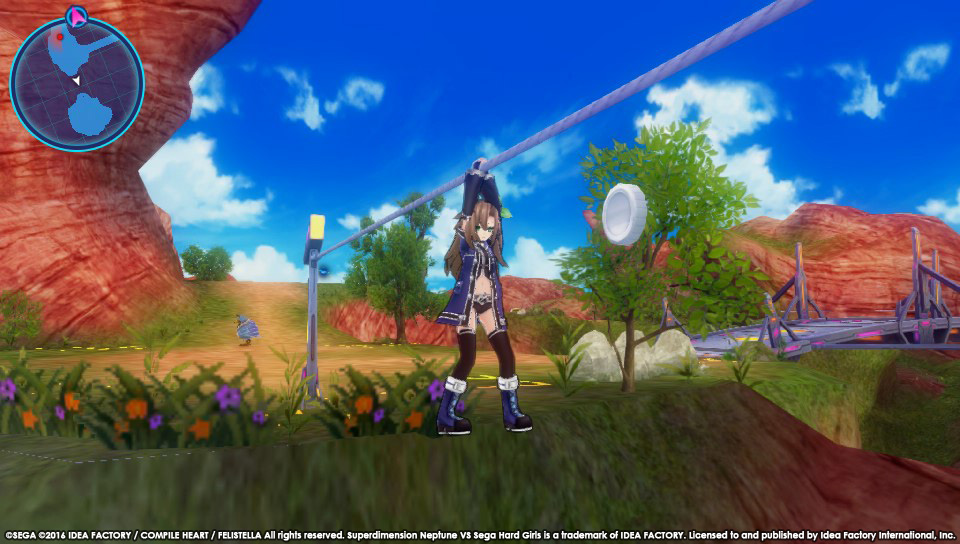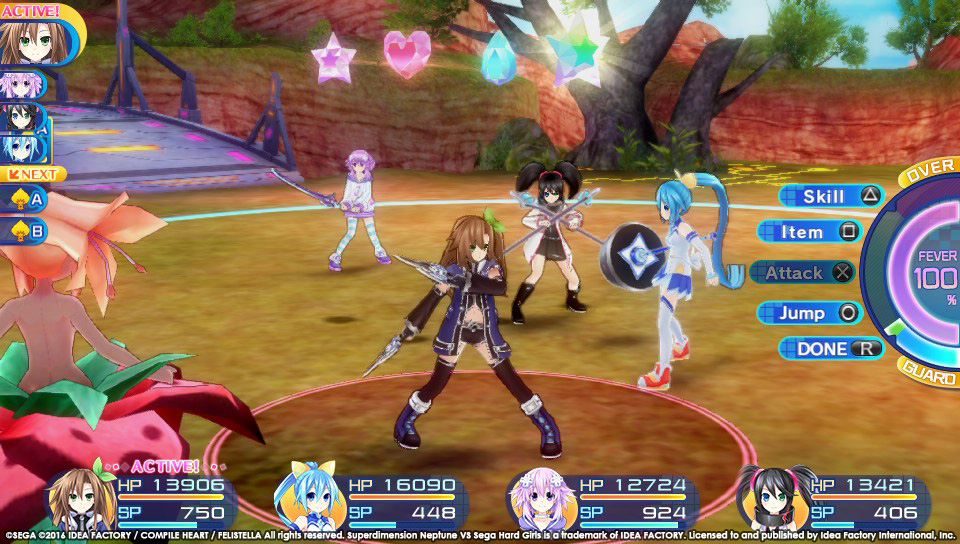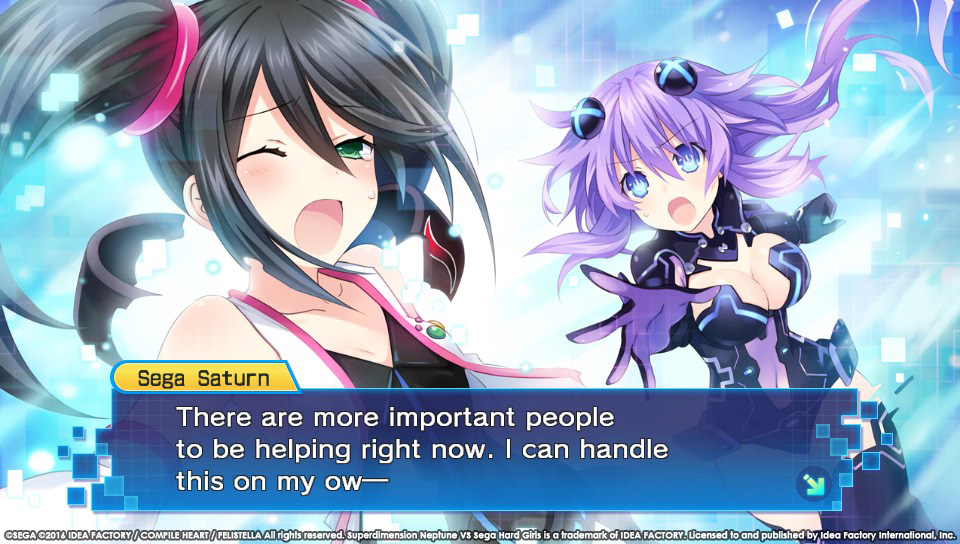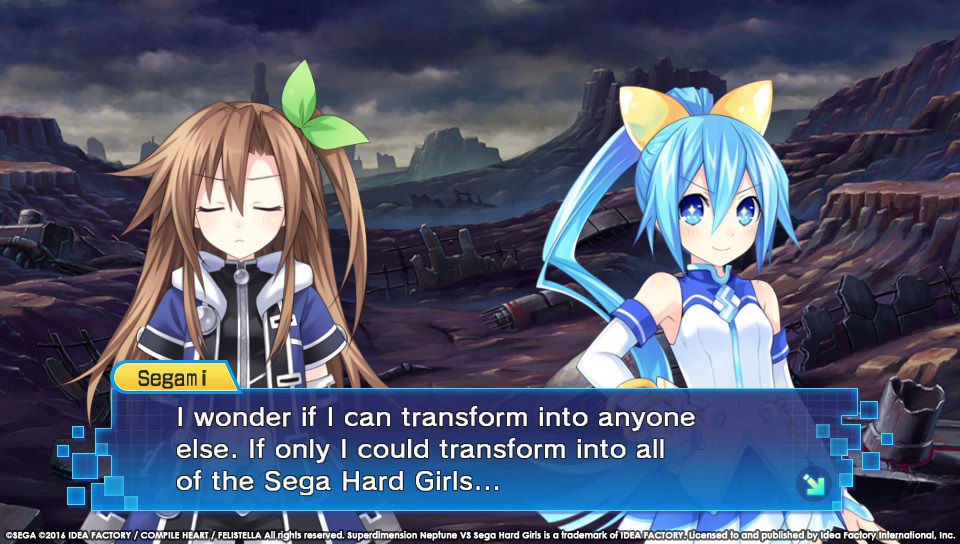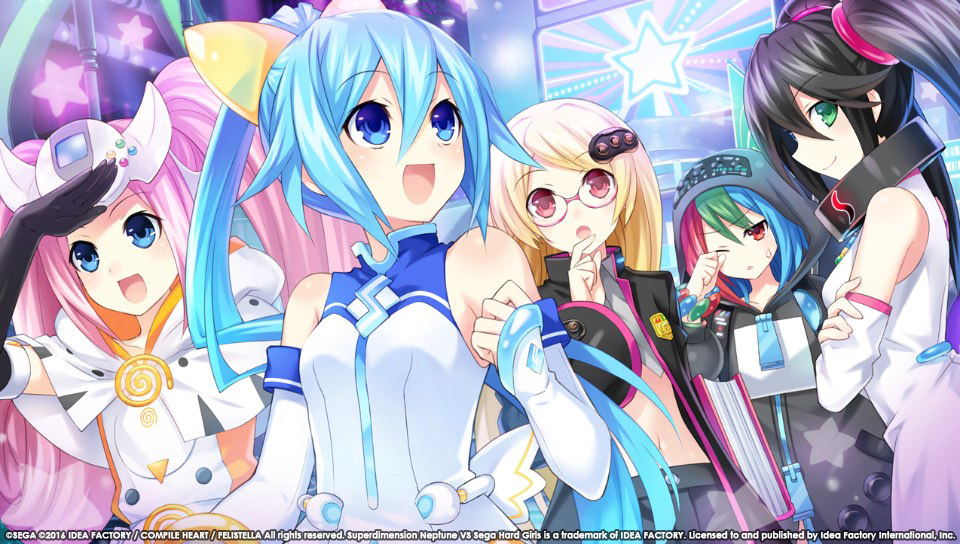The Hyperdimension Neptunia series has released five mainline games, five spin offs and three remakes, while amassing a very loyal fanbase, all in the span of 7 years. To say that this franchise is not prevalent would be a bit of an understatement.
As someone who is unfamiliar with the franchise, many people have recommended Superdimension Neptune VS. Sega Hard Girls as a good entry point for those who haven’t played any of the previous entries, claiming it’s one of the better games in the series. After completing the game, I’m beginning to question the quality of the franchise if this is supposedly one of the best it has to offer.
Superdimension Neptune Vs Sega Hard Girls
Publisher: Idea Factory International
Developer: Compile Heart
Platform: PS Vita (Reviewed)
Release Date: October 18, 2016
Players: 1
Price: $39.99 (Review Copy Provided)
This is a review coupled with a supplemental video review. You can watch the video review above, or read the full review of the game below.
The game’s graphics are nothing to write home about, but they do a serviceable enough job. Dungeon designs are not particularly interesting to look at, with very generic design choices used in each area, with none of them standing out as very interesting locations to explore. It ranges from generic starting forest to generic lava location to generic mainframe-esque dungeon.
Character designs thankfully don’t have this problem, and while the argument could be made that their designs are stereotypically moe, at the very least they are all very distinct from one another and do a very good job at conveying each characters personality, which at the end of the day is what a good character design should do. The 2D models also do a good job at translating themselves into 3D, allowing them to be incredibly expressive during combat
Speaking of combat, the game also does a very good job at portraying its special attacks, giving them some very nice and flashy animations that add a nice punch to them and some needed variety to the combat.
For a game that took me around 20 hours to beat, there is surprisingly little to talk about when it comes to gameplay. Let’s begin with the game’s tutorial. The first hour or so is dedicated to learning the mechanics of the game, which I think it does very poorly. Instead of easing your way and teaching you during combat, the game will stop in its tracks and give you several on a specific mechanic.
It does this so frequently during the beginning that you’ll have a hard time keeping of all the stuff thrown at you. It’s also exacerbated by the fact that they sometimes don’t explain a mechanic properly, leaving you confused at why you can’t do certain things.
Once you do figure everything out, you begin to realize that the game is actually very straightforward. Combat is a pretty standard turn based affair with a bit of a movement mechanic added to the mix. You move each party to face a monster where you proceed to attack them with basic attacks or spells.
You can hold the attack button to unleash a much stronger attack, but at the cost of moving the party members turn order at the very bottom, allowing the enemy more turns to take you out. As you attack enemies you build up a Fever Mode meter, which once activated gives you unlimited turns to eliminate monsters and bosses up until the meter runs out.
While the combat system is functional, I’d hardly call it interesting. For starters, they don’t do a whole lot with the movement mechanics, as the game doesn’t encourage positioning yourselves in smart and strategic positions. The only thing I can see them encouraging is to spread out your party members during boss fights as to avoid getting them all hit with an AoE attack.
On top of that, Fever Mode is incredibly overpowered, as it’s basically the only real way to defeat bosses in an effective manner. It allows you to spam your Limit Breaks, which have no cost by the way, without any fear of retaliation. By the time Fever Mode runs, the fight is either already over or the boss is one attack away from defeat. It removes any incentive to play strategically, and instead grind out enemies until you max out your meter and face the boss.
The other mechanics in the game are woefully underdeveloped and only serve to pad out the game. There is a very bare bones class system, with each character getting a total of 3 classes. The third class is unlocked by maxing out a characters Amie meter, which requires tons of grinding to achieve.
The side quests actually had some potential to be interesting, as they are directly tied to the game’s final boss. You’re given a time limit on each quest, and by completing them you add to your History Level, which in turn gives access to better items. Fail to complete them in time and the Time Eater will devour them and net himself huge buffs, making the eventual confrontation with him much harder.
The big problem with this is that all the side quests are exactly the same. They’re all fetch quests that require the player to, yet again, grind. Some of these quests have some very, VERY small narrative payoffs to them, but they are so insignificant that I only noticed that these quests had a narrative at around the 15 hour mark.
It also doesn’t help that in order to unlock a character’s full potential, you’ll need to grind out items in order to unlock more skill slots and uncap their class level with the latter requiring you to beat a specific area boss. This would be fine on itself but multiple party members require the same items that the bosses’ drops, so if you want to uncap all of them you’re going to have it grind out the bosses multiple times.
One thing I will thank the game for is that throughout the playthrough, it would give me various options that I could turn on or off that actually cut down significantly on a lot of the grinding. It doesn’t outright eliminate, as most of your time will be spent doing that, but it is appreciated that they recognized what people would potentially turned off by.
Normally at this point I’d talk about the games soundtrack, if I could actually remember any of the tracks. The music is so forgettable and so bland that I can’t be bothered to remember any of the tracks. The only song I do remember is the Library theme, but that’s more so from the frequency I was in the library rather than the track itself being memorable.
The game comes with dual audio track, so people who can’t stand dubs will be happy to hear that. I primarily played the game in Japanese, but I did sample a bit of the English dub. From what I heard of the dub it’s fine for the source material, so if you find yourself in the group that prefers dubs you’ll be more than happy.
As for the sub the acting was all around pretty solid, with each voice actress fitting her character’s personality very well. I guess the only minor complaint I have in this regard is that none of the performances really stood out as exemplary. The only character that really comes to mind is Neptune, but that boils down to the character’s writing rather than the performance itself.
On the subject of writing, this is actually Superdimension Neptune VS Sega Hard Girl’s strongest aspect. It’s a pretty basic story where IF and the amnesiac Segami have to travel in time to prevent the Time Eater from eating up history by stopping the conflicts between the Sega Hard Girls and the Goddesses of each time period.
The story very rarely takes itself too seriously, instead opting for a more light hearted comedic adventure. In fact the comedy is always prevalent throughout the story’s dialogue, and I think it hits the mark most of the time. The comedy is mostly self-deprecating and fourth wall breaking which given the games aesthetic provides some really funny juxtaposition.
It also pokes fun at its premise, displaying the various fallacies that come with time travel stories. It can go a little too far with some of its fourth wall breaking jokes, but by the time I started getting tired of them the game was quickly approaching its conclusion.
The comedy is made funnier by its cast. This again is due to the juxtaposition of the humor and what I’d expect from these characters. They are surprisingly crass and crude throughout the entire game, which made it all the more funny given their designs.
I wouldn’t necessarily call them well written, if anything the entire cast feels quite underwritten, but given the focus of the story, they make up for it by the dialogue they bounce off of one another.
The standout character in this regard is Neptune, who essentially acts as a parody to JRPG narrative tropes while also acting as the butt of most of the jokes throughout the story.
Superdimension Neptune VS Sega Hard Girls is a pretty average game that’s only slightly elevated by its writing. Unless you’re a fan of the franchise or like games with cute girls in them, and even then there are better games with cute girls, then I wouldn’t recommend it.
However, if you’re not looking for anything too intense and don’t mind grinding for hours on end with the backdrop of a legitimately entertaining story, then I might give a soft recommendation. Other than that, it does too little to make itself standout from the ocean of JRPGs on the Vita, and you’re honestly better off finding something else too play.
Superdimension Neptunia VS. Sega Hard Girls was reviewed on PS Vita using a review copy provided by Idea Factory International. You can find additional information about Niche Gamer’s review/ethics policy here.
The Verdict: 6
The Good:
- Funny writing and characters
- Somewhat interesting mechanic for side quests
The Bad:
- Gameplay gets stale very fast
- Sidequests are all identical
- Fever Mode basically makes the game trivial
